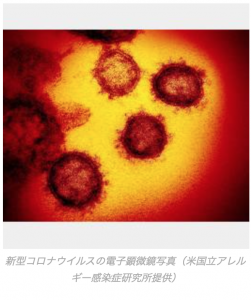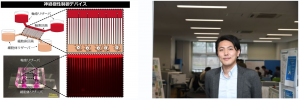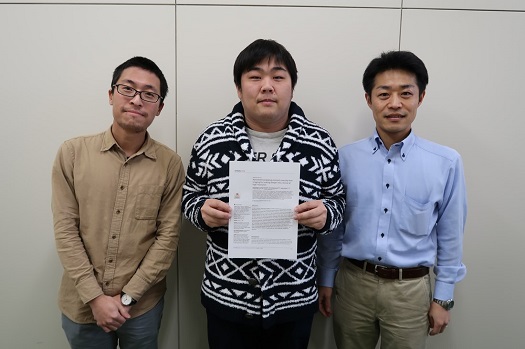A paper by Prof. Kita and his colleagues was selected for the cover page of Macromolecules
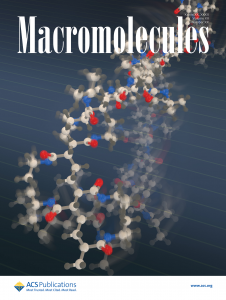
Separation of Micro-Brownian Motion and Side-Group Rotational Motion for Poly(N-isopropylacrylamide) in 1,4-Dioxane Studied by Dielectric Relaxation Spectroscopy
Isala Dueramae, Taisei Ishiyama, Ayumi Torigaki, Shinya Nakano, Kaito Sasaki, Rio Kita, Naoki Shinyashiki, Shin Yagihara, Yukiteru Katsumoto, and Masaru Yoneyama
Macromolecules 2023, 56, 4041–4048.
https://doi.org/10.1021/acs.macromol.3c00064
A paper by Prof. Kimura and Prof. Fujii was selected for the cover page of Lab on a Chip
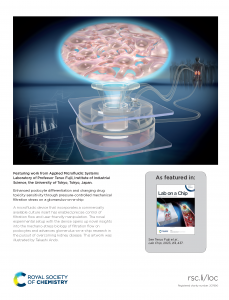
Enhanced podocyte differentiation and changing drug toxicity sensitivity through pressure controlled mechanical filtration stress on a glomerulus-on-a-chip
Doi, Kotaro; Kimura, Hiroshik Kim, Soo Hyeon; Kaneda, Shohei; Wada, Takehiko; Tanaka, Tetsuhiro; Shimizu, Akira; Sano, Takanori; Chikamori, Masamichi; Shinohara, Marie; Matsunaga, Yukiko T.; Nangaku, Masaomi; Fujii, Teruo
Lab on a Chip, 2023, 23, 437
https://doi.org/10.1039/D2LC00941B
A paper by Prof. Koguchi was selected for the cover page of Org. Biomol. Chem.
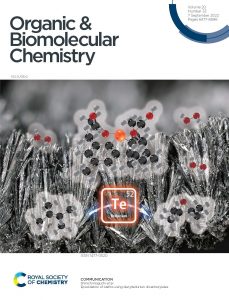 Epoxidation of Olefins Using Diaryltellurium Dicarboxylates,
Epoxidation of Olefins Using Diaryltellurium Dicarboxylates,
Yuga Shibuya, Shiori Ohmura, Akane Ito, Makoto Oba and Shinichi Koguchi,
Organic & Biomolecular Chemistry 2022, 20, 6528-6531.
DOI https://doi.org/10.1039/D2OB01020H
A paper by Prof. Kanie was selected for the cover page of ChemPlusChem.
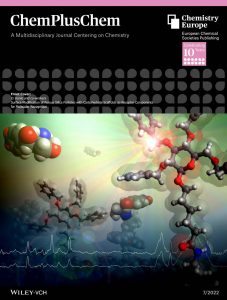
Surface Modification of Porous Silica Particles with Carbohydrate Scaffolds as Receptor Components for Molecular Recognition
Tsukasa Uchida,Ayano Nakamura,Hannah Shimazaki, Yoshimi Kanie, Osamu Kanie, T. Uchida, A. Nakamura, H. Shimazaki, Y. Kanie, O. Kanie, ChemPlusChem 2022, 87, e202200149.
Researcher Interview Vol.2, “Microfluidic device technology that embodies medical science and engineering collaboration”
―Please tell us about your research.
My aim is to cultivate new research fields and industries by bringing micro / nano device technology specifically from the engineering field together with a diversity of other research fields. As the name implies, our micro / nano device is a small machine, and with the use of semiconductor microfabrication technology and 3D printers / plotters, we can custom design and process these micron-ranged small spaces. We are focused on integrating such devices together with biotechnology, and are working hard every day to develop systems that can be applied to medicine and drug discovery. By handling living cells and rebuilding biological functions in a small artificially created space, our research hopes to both replace animal experiments in drug discovery as well as to elucidate unknown life phenomena. Indeed, what we are developing is a hybrid mechanical-biological system. A system which skillfully combines seemingly incompatible things such as machines and living things, not only affords greater convenience for its medical applications, but it also sets the stage for new discoveries.
=> Continue to News
______________________________________________________
_________________________________
An article by Dr. So Nakagawa was published in Daily Gendai on April 21. “What is the difference between the new coronavirus and the 9% lethal SARS?”
Apr.21, 2020
Many people think of the new coronavirus as “a little heavy flu,” but it’s a mistake. In fact, it is the same coronavirus as the “Severe Acute Respiratory Syndrome (SARS) virus” with a fatality rate of 9.6%, and the genes are also very similar. How long? Interview with Dr. So Nakagawa, Ph.D., who is a postdoctoral researcher at the National Institute of Genetics, a visiting researcher at Harvard University, and a lecturer at the Molecular Life Sciences School of Medicine, Tokai University.
“The similarity of the genes that make up each virus is about 70 to 90%. However, the new coronavirus is not an evolution of the SARS virus. They are like relatives. One of the genes with the lowest similarity compared to each other is the S gene. ” The spike protein (S protein) forming the viral protrusion has the role of binding to the receptor on the surface of the infected cell and mediating the fusion of the viral outer membrane and cell membrane. The S gene has a design drawing that determines the character of the S protein and creates it faithfully.
(Continued to the Daily Gendai official website)
_____________________________________________________
Comparative Virology and Genomic Analysis of the New Coronavirus
Apr. 28, 2020
Undergraduate School of Medicine, Department of Molecular Life Sciences, Basic Medical Science and Molecular Medicine Junior Associate Professor So Nakagawa (The Institute of Medical Sciences and Micro/Nano Technology Center) and Associate Professor Takayuki Miyazawa of the Institute for Frontier Life and Medical Sciences, Kyoto University published a special feature in the May edition of Jikken Igaku (Yodosha).
The article, titled “Comparative Virology and Comparative Genomic Analysis of the Novel Coronavirus SARS-CoV-2,” was also included in the online version of the publication. Nakagawa is an expert in genomics and bioinformatics whose research focuses on the coevolution on viruses and their hosts. The article was submitted after a request from the publishing company. It analyzes the new coronavirus SARS-CoV-2 from the view of comparative virology and genomics, building off of the published research of many other scientists. The article describes the virological classification and properties of SARS-CoV-2, its genomic structure, and spontaneous mutations.
See the full text www.u-tokai.ac.jp
*The online version of the article published in Jikken Igaku is available at the website below (Japanese only). https://www.yodosha.co.jp/jikkenigaku/special/SARS-CoV-2.html
(You must register for a free Yodosha HP membership to view the article.)
 Picture is cited from Tokai website 2020
Picture is cited from Tokai website 2020(Retrieved from www.u-tokai.ac.jp)
________________________________
Tokai Project Selected for AMED Translational Research Strategic Promotion Program
Mar. 24, 2020
A project run by the research group of School of Engineering, Department of Mechanical Engineering Associate Professor Hiroshi Kimura (Micro/Nano Technology Center, Tokai University) called “Building a Model for Amyotrophic Lateral Sclerosis (ALS) with Physiological Neuromuscular Junction” was recently selected as a Japan Agency for Medical Research and Development (AMED) Translational Research Strategic Promotion Program Multidisciplinary Research Development Support Project. The goal of the program is to promote the creation of innovative medicines, medical devices, and other medical-related items by constructing a system to effectively translate promising basic research results into clinical research and practical application. This particular project is implemented by the Metropolitan Academic Research Consortium (MARC), which is composed of clinical research institutions, particularly at private universities, in the metropolitan Tokyo area. The initiative is aimed at the development of innovative medicines and medical devices in Japan, focusing on projects by researchers at universities with a medical school who do not themselves belong to the medical faculty.
Associate Professor Kimura is working to develop a microfluidic device which artificially imitates nerve tissues and the functions of various organs, such as the kidney and liver. Utilizing this technology, Kimura is conducting joint research with School of Medicine Professor Shinji Hadano and Assistant Professor Asako Otomo to explain the mechanisms behind ALS. Through the project chosen by AMED, they hope to further develop their research.
(Retrieved from www.u-tokai.ac.jp)
_____________________________________________________
Full-scale Sales Begin for “Myell” Nanosheet Used in Microscopic Observations
March 17, 2020
 ]
]Picture is cited from Tokai website 2020
The university-originating venture Tune Co. Ltd., established by a group led by Tokai University Micro/Nano Technology Center Director and School of Science Professor Rio Kita, began full-scale sales of Myell™, a nanosheet for use in microscopic observations. Myell was produced as a result of joint research between the Center and Nikon Instech Co., Ltd. as well as patented technology from Tokai University. It is a polymeric ultra-thin film that can serve as a replacement for the cover glass typically used in microscopic observations, offering potential benefits for the fields of bioscience, medicine, biology, and many others. Myell will be sold exclusively by Funakoshi Co., Ltd., a retailer of research instruments and other related products.
Click here for the official website of Tokai university
Research group of Associate Professor Tomita of the Department of Chemistry received the 2019 Joint Research Award for Materials and Devices

Picture is cited from Tokai website 2020
A research group led by Associate Professor Tsuneyuki Tomita of the Faculty of Science, Faculty of Science has recently won the 2019 Joint Research Award for Materials and Devices at the Joint Research Center for Materials and Devices. At the 9th Joint Research Center for Materials and Devices Research Activity Report and the Dynamic Alliance Achievement Report for 2018-Evolving Joint Research Center Organization held at Senri Life Science Center in Osaka on July 1. The award ceremony was held, and Prof. Tomita was present.
Research group of Associate Professor Okamura and Researcher Zhang have developed a new technology to observe biological samples deeper and deeper with an optical microscope
Associate Professor Yosuke Okamura (Micro / Nano Research and Development Center) and Researcher Hiroshi Zhang of the Department of Applied Chemistry (Faculty of Engineering) have recently used biological optical microscopes to make biological samples deeper and deeper using a common optical microscope using water-repellent nanosheets. We have developed a new technology that can observe up to. A paper summarizing the results was published in the online journal “PLOS ONE” on science on January 10.
[Title] Nanosheet wrapping-assisted coverslip-free imaging for looking deeper into a tissue at high resolution
[Paper URL] https://journals.plos.org/plosone/article?id=10.1371/journal.pone.0227650
Series Researcher Interview Vol. 1 Rio Kita. Feb 6th. 2020
Tokai University Micro / Nano Research and Development Center Researcher Interview
“Fascinated by the physical universality of soft materials and system-dependent diversity”
Rio Kita. Professor, Department of Physics, Faculty of Science, Micro and Nano Research and Development Center, Tokai University
(Published on Feb 2020, interviewed by Takahashi and Mori)
―Please tell us about your research.
If I roughly divide my research,
① Study on phase equilibrium and phase separation dynamics of polymer solution
② Analysis of blood rheology and gelation of plasma proteins
③ Characterization of polymer (Study on molecular properties in thermal equilibrium)
④ Analysis of irreversible transport phenomena in non-equilibrium phenomena of polymers
⑤ Molecular dynamics analysis of soft materials
In short, it means “to study the properties of soft substances at the molecular level.“
Since joining Tokai University in 2005, I have been conducting molecular dynamics research on soft materials as a member of the Dielectric Spectroscopy Group with Prof. Shin Yagihara and Prof. Naoki Shinyashiki of the Department of Physics. Soft materials containing water (synthetic polymers [Ref. 1-7], gels [Ref. 8-11], biopolymers etc. [Ref. 12-16], mixed solution of low molecules [Ref. 17-19], ultra thin polymer film we have been studying the molecular properties of dispersions,using various methods such as laser interferometry, light scattering, small-angle X-ray scattering, thermal analysis, viscoelasticity measurement, and broadband dielectric spectroscopy.
As a subject of physics, we are actively adopting basic research on the structure and function of biological macromolecules such as polysaccharides, nucleic acids, and proteins, which are complex systems, and methods and methodologies of polymer physics. In addition, it will be quite challenging in terms of physics. Based on this, we also conduct molecular biology research and research aimed at industrial applications. Recently, in cooperation with the teachers of the Micro / Nano Research and Development Center, we are focusing on fusion research between humanities and science, and hope to return the results to education.
-Please tell us about your activities at the Micro / Nano Research and Development Center.
In 2014, adopted the Private University Strategic Research Support Project “Next-Generation Medical Technology Created from Ultrathin Polymer” (5 years in Tokai University ) by the Ministry of Education, Culture, Sports, Science and Technology, I was involved in the establishment and operation of the company and has been conducting joint research with teachers from each department and department of Tokai University. There were many encounters, and I was able to understand the difficulty of collaborative research beyond the boundaries of the field, as well as experience its effectiveness and the impact of success. Communicating with a variety of professional teachers gives me lots of new realizations and makes me study a lot. Sometimes it’s difficult to keep up, but I feel that it’s also fun.






